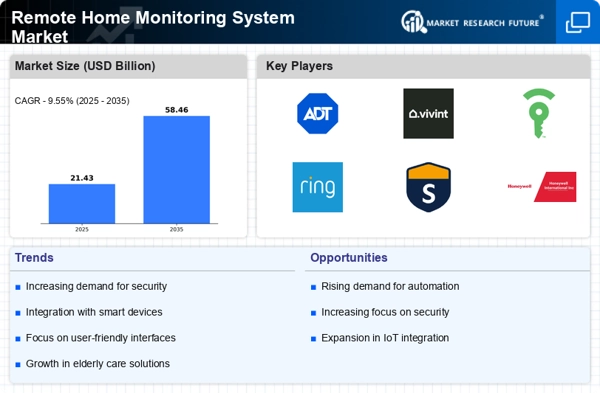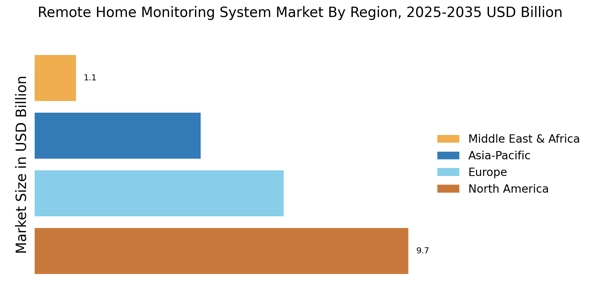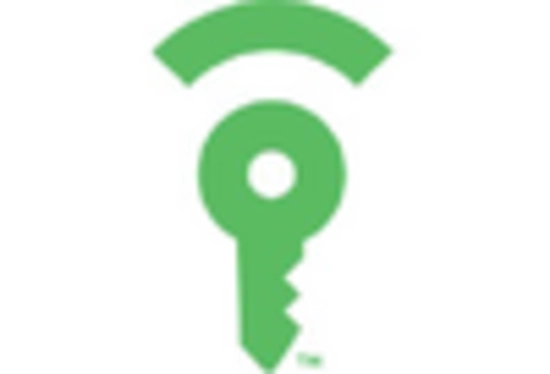Technological Advancements in IoT
Technological advancements in the Internet of Things (IoT) significantly influence the Remote Home Monitoring System Market. The integration of IoT devices enables seamless connectivity and communication between various home monitoring systems, enhancing their functionality and user experience. As of 2025, it is estimated that the number of connected IoT devices will surpass 30 billion, creating a fertile ground for the expansion of remote monitoring solutions. These advancements allow for features such as smart alerts, automated responses, and integration with other smart home devices, which are increasingly appealing to consumers. Thus, the ongoing evolution of IoT technology is likely to drive growth in the Remote Home Monitoring System Market.
Increased Focus on Energy Efficiency
The Remote Home Monitoring System Market is also driven by an increased focus on energy efficiency. Homeowners are becoming more conscious of their energy consumption and are seeking solutions that can help them monitor and manage their energy usage effectively. Remote monitoring systems equipped with energy management features allow users to track their energy consumption in real-time, identify inefficiencies, and make informed decisions to reduce costs. As energy prices continue to rise, the demand for such systems is likely to grow. Reports suggest that the energy management market is projected to reach 10 billion by 2027, indicating a significant opportunity for the Remote Home Monitoring System Market to align with these energy-saving trends.
Growing Adoption of Smart Home Devices
The growing adoption of smart home devices serves as a pivotal driver for the Remote Home Monitoring System Market. As consumers increasingly embrace smart technologies, the integration of remote monitoring systems with other smart devices becomes more prevalent. This interconnectedness enhances the overall user experience, allowing for centralized control and automation of various home functions. Data indicates that the smart home market is expected to reach 174 billion by 2025, reflecting a substantial increase in consumer interest. The synergy between remote monitoring systems and smart home devices not only improves convenience but also elevates security and energy management, thereby propelling the Remote Home Monitoring System Market into a new era of innovation.
Rising Demand for Home Security Solutions
The Remote Home Monitoring System Market experiences a notable surge in demand for home security solutions. As concerns regarding safety and security escalate, homeowners increasingly seek advanced monitoring systems to protect their properties. According to recent data, the home security market is projected to reach a valuation of approximately 75 billion by 2026, indicating a robust growth trajectory. This heightened demand is driven by the desire for real-time surveillance, remote access, and automated alerts, which are integral features of modern monitoring systems. Consequently, manufacturers are innovating to offer comprehensive solutions that cater to these security needs, thereby propelling the Remote Home Monitoring System Market forward.
Aging Population and Health Monitoring Needs
The aging population presents a compelling driver for the Remote Home Monitoring System Market. As the demographic landscape shifts, there is a growing need for health monitoring solutions that cater to elderly individuals living independently. Remote monitoring systems can provide essential health data, ensuring timely interventions and enhancing the quality of life for seniors. Market Research Future indicates that the elderly population is expected to reach 1.5 billion by 2050, underscoring the potential for growth in this sector. By offering features such as fall detection, medication reminders, and health tracking, remote monitoring systems are well-positioned to meet the needs of this demographic, thereby fostering expansion within the Remote Home Monitoring System Market.


















Leave a Comment